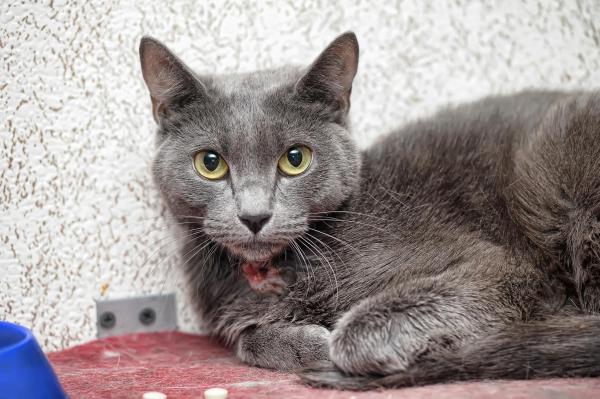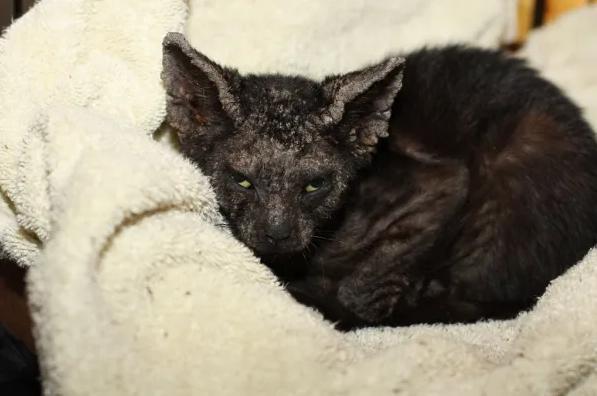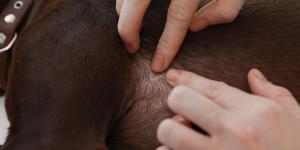My Cat Has Scabs on Their Neck



See files for Cats
Scabs on a cat's skin can be due to various causes, but there are some which are more likely when the scabs appear on a cat's neck. A scab will occur once an open sore has started to heal since the hard crust is part of their immune response. Looking at the larger clinical picture will help us to understand what is causing these sores to develop in the first place. This includes the size, extent and purulence of the scabs, among others. We will also need to look at the cat's behavior and any changes in the home to help inform the diagnosis.
At AnimalWised, we as why my cat has scabs on their neck? We look at the various causes that can lead to scabbing wounds and what treatment options are available for them.
What are scabs on cats?
When a cat's skin breaks, a wound is formed. You can see examples of these in the photo above. While there are many reasons for this occurring and many complications which can arise, the essential wound healing process is the same. As soon as the skin is broken, blood clotting occurs on the open sore which is followed by an inflammatory phase occurs. During this period, antibodies come to the wound site to fight off possible infection.
It is during this first blood clotting phase that the scab is formed. For the regeneration process to function properly, it is important for the wound to protect itself. It does so by sending platelets (a type of blood cell) to the surface of the cat's sore on the neck which harden into the form of a scab.
After some time, the cat's body changes modes. Although it will still provide protection to the wound, fibroblasts will activate to start to regenerate the damaged tissue. This is known as the proliferative phase. When the skin is broken, part of this phase is the process known as epithelialization. This refers to the regeneration of the skin.
Epithelial cells migrate across the wound site to form granulation tissue. They do so under the protective barrier of the scab which will then fall away naturally once the tissue is sufficiently regenerated and can protect itself. For this reason, it is vital you do not pick off or otherwise remove scabs from your cat's neck or any other part of their body.
Now we know what scabs are, we can find out why they appear on a cat's neck.
Cat flea scabs
One of the most common reasons we find scabs on a cat's neck is due to fleas. This is because a favored place to for fleas to bite cats is the neck and shoulder area of cats. The base of the tail and the back legs are also relatively common.
The reaction of the cat will depend on the extent of the flea infestation and the individual cat. When fleas bite the cat's skin, it will cause a reaction. This will lead to inflammation and itchiness for the cat. Unless the cat has a hypersensitivity to flea bites, the bite itself will not usually cause scabs on the skin. However, the itchiness can cause the cat to scratch their ears and neck area to relieve the frustration.
When a cat keeps scratching at their neck, their claws will eventually break the skin and form open wounds. It is from this action that the scabs form on the cat's neck. If the flea infestation continues, the sores will become worse and they will be increasingly more susceptible to secondary bacterial infection.
Treatment of flea bites in cats
The flea bites themselves will usually resolve themselves on their own. The problem is that this cannot happen if the infestation continues. For this reason, the cat will need to have a flea treatment to get rid of the fleas. This is usually in the form of a pipette that is administered to the shoulder blades which will then adsorb over the cat's skin and either kill or deter any fleas.
When the fleas have caused wounds and scabs on the cat's neck, it is likely the veterinarian will administer treatment to help wound healing. This can involve topical antihistamine ointment to reduce inflammation, as well as other salves to ease itching and provide respite to the cat.
An Elizabethan collar will likely be required to prevent the cat scratching while the wounds heal. Antibiotics will be administered if there is a secondary bacterial infection. Once the flea problem is resolved, regular deworming will need to be established to prevent it happening again. This may involve the use of a flea collar which is particularly useful in protecting the cat's neck.
While it is rare, there may be complications when dealing with fleas in cats. Learn more with our related article on complications after cat flea treatment. Although fleas are a common cause, the next section explains why a cat has scabs on their neck, but no fleas.

Pemphigus foliaceus
While it may be one of the most common causes of sores, we also need to know why my cat has scabs on their neck, but no fleas. Another possible causes is pemphigus foliaceus. This is a type of feline autoimmune disease, i.e. a disease mediated by the animal's immune system.
Autoantibodies are produced against proteins of the epidermal stratum spinosum that induce the production of vesicles, blisters and subcorneal pustules that alter the follicles and the skin. In addition, secondary skin lesions such as crusting, exudation, erythema, collarettes and alopecia occur. It is a rare disease that can affect many animal species and can be induced by toxins, allergies, medications or stress.
Treatment of pemphigus foliaceus in cats
Treatment should be based on the use of long-term immunosuppressants. As with any autoimmune disease, it cannot be cured. Fortunately, it can be controlled via symptom management. Many cats require lifelong immunosuppressants, with glucocorticoids being the treatment of choice, especially prednisolone for cats. If the response to prednisolone is not adequate, other immunosuppressants such as dexamethasone or triamcinolone can be used. These are more powerful and have more side effects, so the cat must be closely monitored.
Chlorambucil can also be useful in joint therapy with glucocorticoids to reduce their dosage and potential side effects. They may also be used as monotherapy. Other drugs with immunosuppressive properties that could be used are cyclosporine, gold salts and cyclophosphamide. In any case, it will be a veterinarian who needs to diagnose the condition and prescribe the appropriate treatment.

Bacterial infections
Scabs in cats can appear after bacterial infections. Even on superficial wounds, some bacteria can enter the wound site and cause infection. This can lead to purulent discharge. For this reason, you may see some green discoloration on the scab as it indicates the presence of pus. Scabs can also form over the top of an abscess when the wound is deeper and the infection has worsened.
The cause of these bacterial infections are due to numerous types of bacteria. The initial wound on the cat can have many causes. It may be the result of a fight, a fall, a collision or any other type of trauma which can result in a wound. It may also be a result of any of the other reasons a cat has scabs on their neck, as detailed in this article. The bacteria that usually cause infections in cats are often one of the following:
- Pasteurella multocida
- Prevotella oralis
- Bacteroides spp.
- Fusobacterium spp.
- β-hemolytic streptococci
- Staphylococcus pseudointermedius
After 24 to 48 hours of the introduction of these bacteria, the surrounding tissue becomes infected and inflamed. When the pus cannot escape, it accumulates inside and concentrates in the center. When this abscess is mature it can burst, spreading the pus that will end up drying and forming scabs.
Treatment of bacterial infections in cats
When your cat has an abscess, it is often necessary to lance it and drain the accumulated pus. If the cause is a foreign body entering the skin, then this will need to be removed. The cat will also need to be administered oral or injected antibiotics to defeat the bacterial infection. The duration of treatment can be several weeks if the abscesses are complicated or the infections are prolonged. The antibiotic to choose must be indicated by your veterinarian after performing the culture and antibiogram.

Dermatophytosis (ringworm)
Another of the main causes of scabs on the cat's skin is dermatophytosis, also known as ringworm. Ringworm is an infection of the skin by dermatophytes, a type of fungus that affects cats, as well as dogs and people. It cam appear on almost any part of the skin, but it is common for lesions to appear on the cat's neck. If your cat has ringworm, it is important to know it is a feline disease that can be transferred to humans (zoonosis).
The most frequent fungus responsible for ringworm in cats is Microsporum canis. They can also be affected by other dermatophytes such as Trichophyton mentagrophytes, Microsporum gypseum, Microsporum persicolor, Trichophyton terrestrial and Microsporum fulvum. These fungi tend to most frequently infect younger cats and those with long hair. They can produce skin lesions such as scabs, circular plaques, skin inflammation, redness and scaling, as well as alopecia.
Treatment of ringworm in cats
As it is a contagious zoonotic disease, an exhaustive disinfection of the home must be carried out. We will need to do the same with the toys and accessories with which the infected cat has been in contact. Specific treatment consists of the use of oral antifungal products, with drugs such as itraconazole for cats being commonly administered. Shampoos and creams will also be used as a topical supportive treatment.

External parasites
External parasites perform direct damage to the skin due to their mechanical-irritative action. This is due to their mouthparts, jaws, legs and way of feeding or digging into the skin. This damage produces skin lesions such as scabbing, peeling, inflammation, redness, hair loss, itching and excoriation. We have already mentioned fleas which are a common external parasite on cats.
There are many other external parasites that can affect our cats, but it is especially mites that cause crusty dermatitis on the cat's head and neck. Specifically, notoedric scabies mites (Notoedres cati) are the most common and cause intense itching, papular-crusted erythematous dermatitis, pyoderma, seborrhea and alopecia. It is one of the reasons we may see the cat with bald patches above their eyes.
As seen in the photo below, we can mainly see the scabs in the neck and head area, although the parasitosis can spread to other parts of the body. Another mite that can cause this problem is Cheyletiella blackei which is responsible for ‘walking dandruff disease’. This is due to its particular movement and whitish appearance on the skin and fur of cats. Lice can also cause scabs, alopecia, seborrhea and pediculosis.
If your cat scratches a lot and has scabs on their neck, we should initially consider a parasitosis. However, we will need to go to a veterinary center to confirm treatment.
Treatment of external parasites on cats
It is important we are aware of different types of external parasites in cats and follow an adequate deworming schedule. This also includes protection against internal parasites. This should start when the cat is a kitten, where possible. The veterinarian will establish a deworming schedule.
If this has not been carried out and the cat has a parasitosis, we need to take them to the vet who can administer the correct antiparasitic products. Examples include selamectin to teat mites and fipronil for cat lice. They can then establish a deworming schedule once the infestation is resolved.

Miliary dermatitis
Feline miliary dermatitis is a disease characterized by the formation of a variable number of brown or black crusts and pustules on the skin of cats. They most commonly affect the head, back and neck, although we can also see it on the abdomen. The skin sores and lesions are generally small in size, hence the term ‘miliary’. Itching and rashes always appear.
If your cat has a scab scab on their neck, it may be due to this type of dermatitis. It is usually a hypersensitivity reaction. This is when the cat is sensitive to a particular allergen, especially a food allergy. As seen in the photo below, the scabs are small and can be seen because the hair falls out around them.
Flea bites can cause scabs by scratching, but if the cat has a hypersensitivity to them, it can result in miliary dermatitis even without the scratching. Other problems that can also induce feline miliary dermatitis are infections by dermatophytes and other microbes that cause superficial pyodermas. For all these reasons, this pathology may be a consequence of some of the aforementioned causes.
Treatment of miliary dermatitis in cats
The treatment of miliary dermatitis will depend on the cause. For example:
- Flea bite allergies require elimination of these parasites using insecticides and repellents so they do not come closer to them.
- Parasites are treated with antiparasitic products.
- Allergic cats should stay away from the stimulus that causes hypersensitivity. In cases of food allergies, we must remove the protein or allergen in question that has caused the problem or use a hypoallergenic diet or novel protein pet food.
- Dermatophytosis is treated with antifungal products such as itraconazole and pyodermas in cats require antibiotics.
As you can see, the causes that produce scabs on the skin of cat's neck are varied, but all must be diagnosed and treated by a specialist. If you see your cat has scabs on their neck, go to the veterinary center as soon as possible. You can also look at some more general reasons why your cat has scabs with our related article.

Should you pick off cat scabs?
Picking off scabs from a cat's skin is generally not recommended. Scabs form as part of the body's natural healing process. Picking at them can disrupt this process and potentially lead to complications. Although it may be tempting, the following are some of the important reasons you should not pick off cat scabs:
- Infection risk: picking at scabs can introduce bacteria from your fingers into the wound, increasing the risk of infection. Cats may also scratch and groom themselves, so open wounds are susceptible to contamination from the cat.
- Delayed healing: removing scabs prematurely can disrupt the healing process. Scabs protect the underlying tissue as it repairs. Removing them may expose the wound to further irritation.
- Potential pain and discomfort: picking at scabs can be painful for the cat. If the scab is covering a sensitive or healing area, removing it can cause discomfort and stress for the animal.
- Risk of scarring: constantly picking at scabs can lead to scarring. Allowing the scabs to fall off naturally may result in less noticeable scars as the skin heals.
If you notice scabs on your cat, it's essential to determine the underlying cause. This will need to be carried out by a qualified veterinarian. As you can see with the above causes of scabs on a cat's neck, this is a symptom of many different conditions. Trying to treat the problem ourselves will likely worsen the problem. We can provide the wrong treatment or delay the right treatment to the extent that the cat becomes seriously ill.

This article is purely informative. AnimalWised does not have the authority to prescribe any veterinary treatment or create a diagnosis. We invite you to take your pet to the veterinarian if they are suffering from any condition or pain.
If you want to read similar articles to My Cat Has Scabs on Their Neck, we recommend you visit our Skin problems category.
- Harvey, R. G., & Mckeever, P. J. (2001). Illustrated manual of skin diseases in the dog and cat. Grass editions.






 Do you know wat this is from my cat neck
Do you know wat this is from my cat neck






